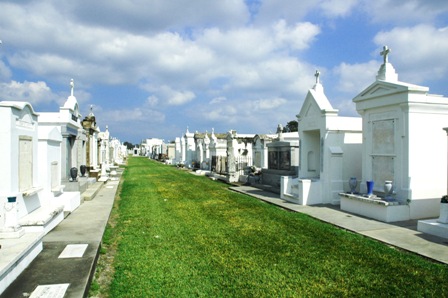THE ELUSIVE CHARACTER OF NEW ORLEANS
By Ray Chatelin
(For Travel Writers' Tales)

Defining New Orleans is a bit like chasing a butterfly. Just when you think you have it in your grasp, it flits away. For New Orleans is America's most historically and culturally complex city, wrapped in a cloak of decadence.
You can revel in its historical sites, gorge yourself with its unique cuisine, walk for days among its 18 th and 19 th Century buildings, listen to its musical heritage, or delight in its tolerance of virtually anything provided it has flair.
It's a place where excess is excused and, along Bourbon Street in the French Quarter, even encouraged. It takes pride in its history of Voodoo and its Mardi Gras is celebrated with unbridled exuberance, style, and unabashed enthusiasm. Somehow, the city manages to resist Americanization.
Originally settled by the French in 1718 by Jean-Baptiste Le Moyne (whose name you'll hear often in New Orleans), it was named for the French Regent, Philippe, Duc d'Orleans.
When 2,000 French settlers were expelled by the British from Nova Scotia in the mid-18 th Century and turned up in Louisiana, they became known as Cajuns. Those born in Louisiana of European ancestry were called Creoles. Both cultures remain today as part of the New Orleans experience.

The French Quarter is to New Orleans what Montmartre is to Paris, the Old Town is to Quebec City - it's ancient heart.
About a dozen buildings date from the original site, the oldest being the stately Convent of the Ursulines at 1100 Chartres, completed in 1753.
Along Royal Street you'll find dozens of antique stores; on Bourbon Street (named for a royal family in France and not the amber-colored booze) are countless bars, street performers and open-air music parlors. walking and horse-drawn carriage tours, and mini-bus tours.
Nearby neighborhoods reflect a different New Orleans, no less rich in history and character. The Garden District, for example, was subdivided from cotton plantations and some great mansions have remained along historic St. Charles Street.
There you'll find gourmet restaurants, chic boutiques, and two universities – Tulane and Loyola - Magnolia Trees, gigantic Oak trees, and night-blooming jasmine mark the area and it's one of the city's most popular.
Still, the soul of New Orleans is found in its music. It's why you go there, just as art is why you go to Florence. While there's no shortage of where to experience New Orleans Jazz and Dixieland, two places stand out: Preservation Hall (726 St. Peter St.) and the Palm Court Jazz Café (1204 Decatur).
At Preservation Hall, old style New Orleans jazz is performed by seasoned veterans in one of the city's oldest spaces. Get there early or you'll find yourself standing since the hall has a seating capacity of about 50.
At the Palm Court Jazz Café, a younger generation performs classic and traditional jazz in a 19 th Century building that also serves as a café. There are few places in the French Quarter that offer this combination of dining and music.
Bring your fat clothes. You're going to need them. The Creole heritage goes back more than 250 years and you'll also find strong French, Spanish, African, Irish, Italian, and Haitian French culinary traditions.
The French Quarter is packed with places to satisfy your cravings for everything from traditional to nouveau cuisine. You can't leave it without sampling the traditional Muffaletta sandwich at Central Grocery. And for authentic gumbo, have lunch at the Gumbo Shop (630 Saint Peter).
Familiar brand hotel chains edge the French Quarter since New Orleans is a major convention city. But, try the bed and breakfasts on the borders of the French and Garden quarters, or the intimate inns and small hotels in the heart of the French Quarter itself.
The Degas House (2306 Esplanade Ave.), for example, offers the only place in the world where you can sleep where the French Impressionist master, Edgar Degas, once lived.

Graveyards are a major tourist attraction. These “cities of the dead” are distinguished by above-ground decorative, rusty ironwork, and sun-bleached tombs. The older cemeteries are St. Louis No. 1, 2 and 3, located near the French Quarter. Pirates, politicians and voodoo queens are interred there. Take a scheduled tour. It's more fun.
A swamp tour, and a tour of the Mardi-Gras parade floats that are built on the south shore of the Mississippi are a must-see. Honey Island Swamp Tours (985- 641-1769) takes you close and personal with those who live there and a variety of swamp creatures.
Mardi-Gras World, (504-361-7821) daily tours take you behind the scenes and virtually into the construction of parade floats for the 30 or more Mardi-gras parades.
_______________________________
PHOTOS by Toshi